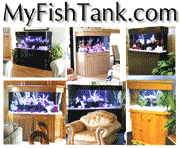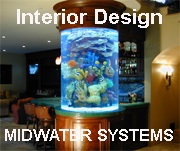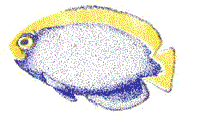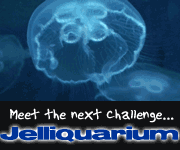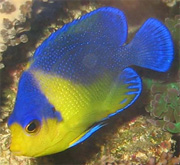|
Algae, Basic Biology
By. Jim Wolf C.S.U.N. Marine Biologist
Algae are called "autotrophic organisms", and this means that they produce
their own food by a process called photosynthesis. This process allows
for the conversion of carbon dioxide (CO2) and water (H2O) in the presence
of light and chlorophyll to create oxygen and simple sugars. This crucial
process is responsible for supporting much of the life on this planet.
Under conditions of optimum photosynthesis, algae put off large amount
of oxygen, clean up the water, as well as provide food for other organisms.
Suffice to say that it is a good idea to encourage algae to grow in aquariums
for they help to create a more natural and stable environment.
Some of the more crucial factors that affect the growth of algae are:
light, water flow, temperature, nutrient concentrations, and competition
(both from other algae, as well as many organisms that might eat or compete
with the algae). Lets now consider each of these factors in more detail.
Light by far is the most critical factor. Many coral reefs are characterized
by having very high levels of light intensity, and so salt water aquariums
require large amounts of lighting. The quantity, spectrum, and duration
all influence not only what types of algae are present, but their relative
abundance. Using traditional fluorescent lights, it is virtually impossible
to over light a salt water aquarium. A photo period (the amount of time
the light is actually on) of about 12-16 hours a day is good. If there
are many lights on an aquarium, it is a good idea to turn them on and off
in succession. This will help simulate the natural rise and fall of the
sun. Lighting considerations are tank specific and to compute the amount
of light required calls for specific numbers (depth, bulb number, organism
types et.) For a good review of the pertinent facts see Martin Moe's Marine
Aquarium Reference.
Nutrient concentrations also affect algae populations. Many types of
hair algae and slime algae grow in response to excess nutrients (particularly
nitrates and phosphates). Coral reefs are especially low in nutrients,
this coupled with the vast amounts of herbivores (plant eaters) keeps algae
populations low on reefs. Certain macroalgaes require supplements of iron
and other trace elements to keep them healthy. Tanks with poor lighting,
excess nutrients, and low flow often have excessive amounts of unattractive
slime and filamentous algae. Flow affects algae in the following way. Areas
of low flow are referred to as stagnant. In these stagnant waters the algae
quickly uses up the available CO2 and nutrients and subsequently stop photosynthesizing.
Many desirable macro algae require high flow to insure adequate nutrient
supply. These algae should appear to be moving in the current. If this
is not so, they may be quickly overtaken by other undesirable "low flow"
film forming algae . Temperature usually only affects algae communities
if it deviates too much (not a problem in temperature controlled tanks).
|
